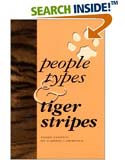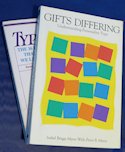
- About the MBTI
- Verify Your MBTI Type
- Personality Patterns
- MBTI Articles & Resources
- Article Directory for Educators & Students
- Books on Personality Types
- Emotional Intelligence & Personality Type
- Career Planning & MBTI
- MBTI Business Applications
- Lenore Thomson - Carl Jung Personality Type
- Site Map - Master Directory of All Articles
- MBTI Consultant Links
- Personality Type Workshops & Conferences
- Links to Other Type Websites
- Murder Mystery Business Theatre
- About Us
How Learning Style Affects Career & Educational Success
Career Choice and Career Development: Using the MBTI ® and Personality Type
By Ross Reinhold, INTJ Page 2 (continued)
Article Index
Page 1. Mbti Career Choice
Page 2. Mbti Learning Style
Page 3. Mbti Job Challenges
Page 4. Mbti Job Search
The patterns of personality associated with the 16 personality types impact how we best learn and can assist in utilizing learning techniques and picking types of career related college educational programs that allow us to use the strengths of our learning style.
Each of the preference dichotomies (E vs I, S vs N, T vs F, and J vs P) impact this style. Gordon Lawrence (author of People Types & Tiger Stripes and Looking at Type and Learning Styles) believes the most influential pair is Sensing vs. Intuition. This makes sense and seems intuitively accurate ![]() . . . for S and N are about how we perceive, the manner in which we take in information. In People Types (p. 140) Lawrence (whose type letters are ENTP) relates an experience from his early teaching days to highlight this difference:
. . . for S and N are about how we perceive, the manner in which we take in information. In People Types (p. 140) Lawrence (whose type letters are ENTP) relates an experience from his early teaching days to highlight this difference:
"When I taught high school social studies, long before I knew about psychological type, I knew some of us in the department emphasized facts and some emphasized general concepts - all using the same textbooks. I taught the facts of American History only to illustrate the general concepts I thought were important. That seemed to me the much better way, and I felt superior to those who just taught the facts, not knowing, of course, that I was merely exercising my intuitive bias."
As a learner I also had an "intuitive bias" which for some courses and circumstances served me well. But for some courses and during some stages of my development, it was a handicap that put me on the brink of failure on more than one occasion. I only succeeded in the long run in school by accidentally discovering some study techniques that helped compensate for my intuitive nature (or conversely be able to employ it effectively).
I now know that I often must first obtain an overall grasp or understanding about a concept or about how a thing works before I am able to assimilate the details or facts about something. When I read something, I am as if skimming the tops of waves; I don't get too deep into the material nor can I recall much of the detail that I've just read. Yet I will stop periodically and re-read sections as if a thread has been broken and I need to re-tie it. My mind is sucking up the details and forming them into patterns and it is the patterns that my head seems to want. Once these patterns are formed, I can much easier go back over the material and now focus on remembering the details. Still my conscious mind seems rooted in that pattern and overall concept orientation that is characteristic of Intuition. Facts and details seem more stuck in a dark back room of my mind and can be hard to find. On one of those TV quiz shows where a question is asked open-ended with no prompts, I don't do near as well in coming up with a correct answer as when there are multiple choices. In the latter case, the clues seem to bring forth the right answer from that back room storage of facts and details.
In reflecting on my own educational trials and successes and on my experiences as a training and development professional (before learning about type), I realize how much teachers are a slave to their own mental patterns of personality type and how a learner can be either handicapped or aided by the teachers style and/or by the nature of the content to be learned. Instructional styles or techniques sometimes come in vogue and educators are taught to employ them in a way that assumes all learners are basically alike. A good deal of educational doctrine is a quest for finding the best scheme of instruction and then propagating this strategy throughout an educational system. This one-best-way mentality usually means some kinds of learners are put at a disadvantage. A learner caught with a teacher or in an instructional model not fitting his or her learning style is at a handicap. But if you have learned about your style, understand both the strengths and weaknesses of that style, you've got a fighting chance to self-direct your learning to enhance your chances of success.
Outlining the different learning styles and in particular assisting the reader in learning his or her own style is a task beyond the scope of this article. But let me give you a taste and then urge you to look among the references at the end of this piece for some recommended books or resources.
Learning Style and MBTI Personality Type
In Looking at Type and Learning Styles (pp.14 - 20) Gordon Lawrence identifies a number of characteristic ways the different preferences influence learning. Here are just a few snippets from his booklet:
For extraverted (E) students (who do their best when processing thoughts aloud) - small group and partner work is especially important . . . For introverted (I) students (who do their best when engrossed in mental processing) - working in private ways, with internal dialogue, is more important.
For sensing (S) students - it is important to go carefully and thoroughly through new material, not skipping anything. Sensing students want to know for sure that the conclusions they reach are sound, with no gaps, and are based on facts. . . For intuitive (N) students - they want to move quickly to follow wherever their intuition leads and let insight tell them what is worthwhile. This path is not straight nor step by step.
For students preferring thinking (T) - interesting problems to analyze stimulate them. They like to critique things and find flaws that can be fixed. For students preferring feeling (F)- appreciation for who they are (not just the quality of their work) is important. They do best in a warm and friendly classroom atmosphere.
For students who run their outer lives with a perception process (P) working in an ebb-and-flow style energizes them. Their energy for learning comes in bursts, surges, and impulses, sometimes with slack periods in between. For students who run their outer lives with a judgment process (J) organizing their learning into a clear plan, including when they will work and when they will play, and knowing clearly their expectations is important.
While generalities like the above can be useful to the individual learner, Lawrence's learning style profiles (pp. 31 - 54) of each of the 16 types provide more depth and breadth for students looking to capitalize on their unique learning style strengths (and effectively work around what might be their weaknesses).
Because teachers tend to teach according to their own learning style and the structure of college educational programs are sometimes skewed in favor of certain styles (and to the disadvantage of others), a learner needs to be pro-active in managing their education. What works real good for your best friend may not work well at all for you. A top rated educational program or top rated school may not be a good fit for your learning style. Don't necessarily follow the crowd or conventional wisdom; learn the bend of your own twig and use that as your guide.
 Next: Job & Working Challenges & Personality Type.
Next: Job & Working Challenges & Personality Type.
Other Popular or New Articles on Personality Type
![]() Mobile Friendly Version of our Free Personality Type Test
Mobile Friendly Version of our Free Personality Type Test
The Civil War between Feeling and Thinking

Trump - The Mouth that Roared Once Too Often?

® MBTI, Myers-Briggs, Meyers Briggs, and Myers-Briggs Type Indicator are registered trademarks or trademarks of the Myers-Briggs Type Indicator Trust in the United States and other countries (aka meyers briggs or myers briggs).
Return to Myers Briggs, Personality Types, & MBTI Applications Home Page
© Published by Ross Reinhold & Reinhold Development 1997 - 2023
Privacy Policy About Us


